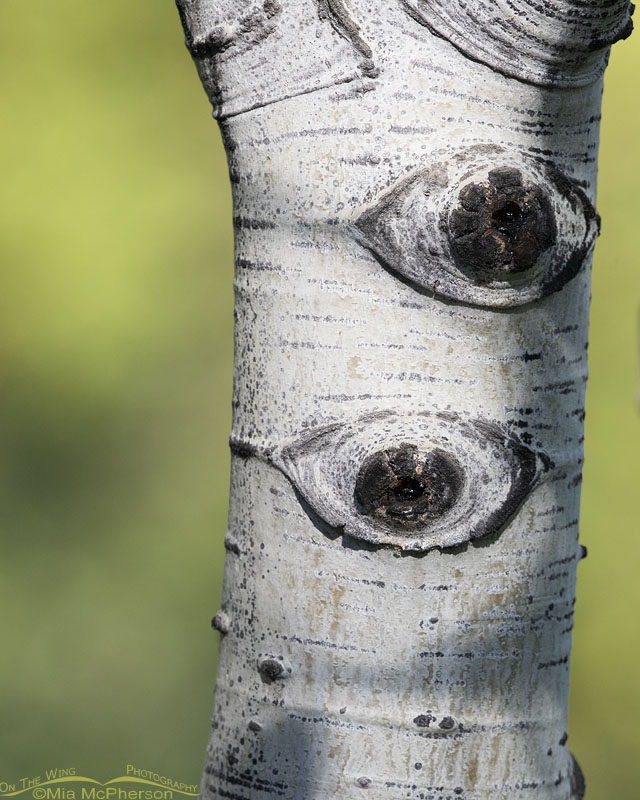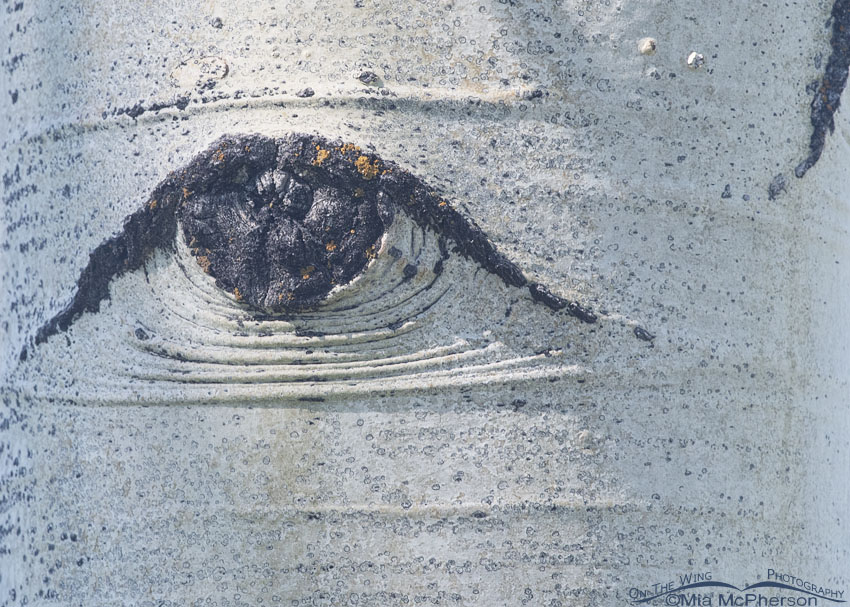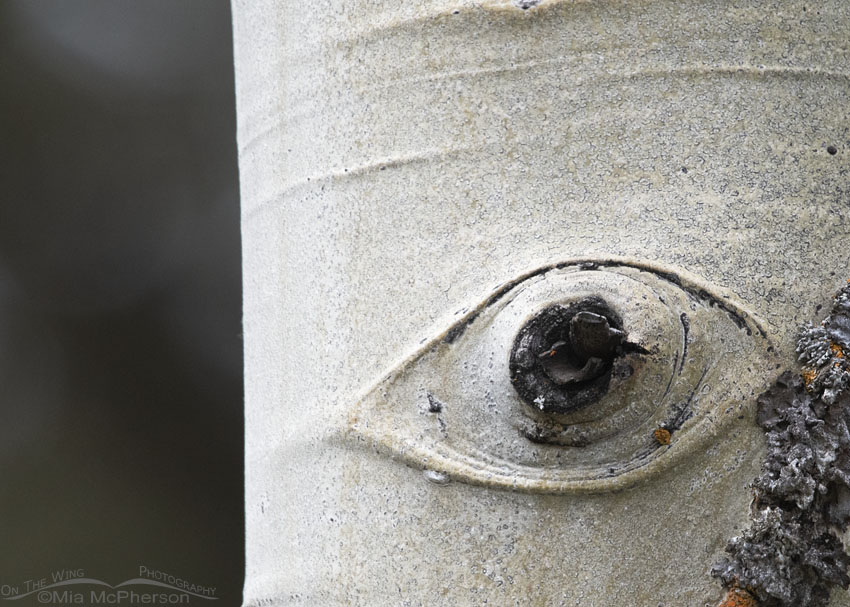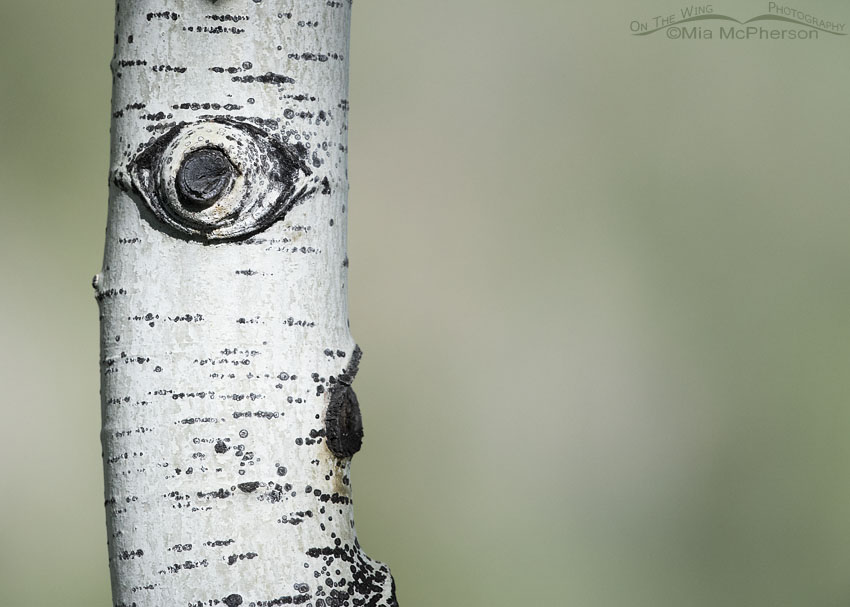 Pair of Aspen Eyes, Uinta Wasatch Cache National Forest – Nikon D810, f7.1, 1/1000, ISO 800, -0.3 EV, Nikkor 500mm, natural light
Pair of Aspen Eyes, Uinta Wasatch Cache National Forest – Nikon D810, f7.1, 1/1000, ISO 800, -0.3 EV, Nikkor 500mm, natural light
Aspen eyes
There are times when bird photography is slow that I look around to see what other wonderful parts of nature I can photograph until the next bird flies in. That isn’t because I feel bored, it is because I know that everything in nature is connected and that makes me feel that I should at the very least observe the habitat around my subjects.
When I am photographing in forests that contain Quaking Aspens I often feel like I am being watched, not in a spooky or supernatural kind of way, but more in a humorous way because Aspens often have eyes. Or perhaps a better way of putting it is that they have features that look like eyes.
 Aspen Eye in the Caribou Targhee National Forest – Nikon D810, f8, 1/500, ISO 400, +0.7 EV, Nikkor 500mm VR with 1.4x TC, natural light
Aspen Eye in the Caribou Targhee National Forest – Nikon D810, f8, 1/500, ISO 400, +0.7 EV, Nikkor 500mm VR with 1.4x TC, natural light
I’ve taken many “Aspen Eye” photographs over the years that I have photographed in Utah, Nevada, Idaho and Montana and these represent just a few of those photos. These aspen eyes form when the tree “self prunes” by dropping smaller branches that don’t receive enough sunlight and that leaves a scar on the trunk of the tree.
 Aspen that has an eye on me – Nikon D810, f13, 1/400, ISO 1000, Nikkor 500mm VR with 1.4x TC, natural light
Aspen that has an eye on me – Nikon D810, f13, 1/400, ISO 1000, Nikkor 500mm VR with 1.4x TC, natural light
Some of the aspens have multiple eyes on their trunks while some have just a few. Each of the eyes are unique. There are times when I have seen sap dripping from the eyes which makes it look as if the tree was crying.
 Sunlit Aspen Eye in the High Uintas – Nikon D810, f7.1, 1/2000, ISO 800, -0.3 EV, Nikkor 500mm, natural light
Sunlit Aspen Eye in the High Uintas – Nikon D810, f7.1, 1/2000, ISO 800, -0.3 EV, Nikkor 500mm, natural light
Maybe the trees should be crying because in 1996 scientists began noticing an increase in dead and dying aspen trees, in some cases entire aspen groves have died. Possible causes for the death of aspens have included overgrazing by domesticated cattle and wild deer and elk who consume the small trees sprouting from the clonal roots so only the older trees remain. Fire suppression could also be a factor, aspens tend to grow back quickly after wildfires because while the tops of the trees may burn the clonal roots survive and will sprout new, healthy trees.
I love seeing the aspen eyes of the forest upon me and I find myself happy to photograph them whenever I can.
Life is good.
Mia
Click here to see more of my wildflower, plant, shrub and tree photos.


The “eyes” have it! These are wonderful shots, Mia! I really enjoy Aspens; they’re such lovely trees.
As a confirmed tree hugger this post sang to me. Sad songs and glad songs.
Your post gave me a big smile today. I too have frequently found faces in trees, I have not photographed them but perhaps I will start and call the collection The Many Faces of Nature.
Actually, they all work for CBS…Your photos prove that…..
(I hope the migraine is finally gone)
Neat post and photos Mia! Now I will never look at aspens the same Funny how sometimes things are right in front of us and we do not recognize them. They really do look like eyes! Thanks for opening my eyes to the eyes.
Funny how sometimes things are right in front of us and we do not recognize them. They really do look like eyes! Thanks for opening my eyes to the eyes.
The Eyes of Texas will never sound the same. I like those wrinkles below the eye in the second image …..
Now I am going to have to check that out! We have so many Aspen forests here but I’ve never thought of the scars as eyes! You have given me a new perspective…thank you.
Beauty is all around us. We only need an open mind to see it.
Thank you for this marvellous post.
OMGosh….I have never noticed the “eyes” on aspens. I will definitely be looking for them now. Thank you for the photos & info.